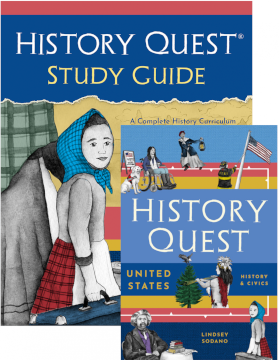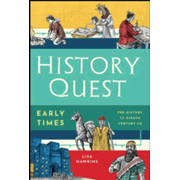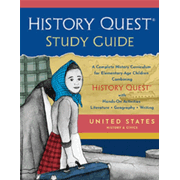The History Quest series serves as an introduction to world and U.S. history from a secular perspective. History Quest has replaced the entire History Odyssey series, also published by Pandia Press. The biggest difference between the two series was that History Odyssey relied entirely on books from other publishers (e.g., Hillyer’s A Child’s History of the World), while History Quest primarily use books published by Pandia Press. (You will still use supplemental books such as The Usborne Encyclopedia of World History with the History Quest courses for world history.)
The world history courses in the History Quest series are titled Early Times, Middle Times, and Modern Times. (Modern Times is not yet available. The other course is titled History Quest: United States History & Civics.
Each course has its own History Quest core text—a compilation of well-written history and stories—and a study guide. The world history core texts are written primarily for use as read-aloud books for children in grades one through four, and the study guides provide activities for those grade levels. Older students in fifth and sixth grade can read the core texts as part of a unit study or along with another resource that provides appropriate grade-level assignments. The United States course is written for grades three through six.
Both the core texts and study guides are available in print and digital versions. Audiobook versions are also available—these can be huge time-savers for busy parents, a help to auditory learners, and another way to reinforce learning.
Modern History Bridge
Eventually, Modern Times, the third History Quest course, will complete the cycle of world history for the elementary grades. Until that course becomes available, there is a gap in history coverage after the first two History Quest courses and before students are ready for the first book of the History Odyssey series. In the meantime, Pandia Press has created Modern History Bridge from their former History Odyssey guides for the elementary level. Modern History Bridge is a year-long, modern history course geared toward grades three through seven. It uses The Story of the World: Volume 4, The Usborne Encyclopedia of World History: with Internet Links, a classic novel, a biography of Thomas Edison, Number the Stars by Lois Lowry, and The Breadwinner by Deborah Ellis.
Core Texts
The History Quest: Early Times core text was written by Lisa Hawkins, and both History Quest: Middle Times and History Quest: United States History & Civics were written by Lindsey Sodano, but they share the same approach and style of writing. These core texts were written to be both engaging for children and strongly based on historical facts. Written from a secular point of view, they combine storytelling with the presentation of more-comprehensive historical information.
The world history core texts avoid promoting religious, cultural, or political agendas, but the United States core text has decidedly progressive content. All of the core texts include information about influential women and underrepresented groups. They include discussions about various religions and their practices without promoting any of them. Christianity receives very little attention in contrast to the discussion of other religions which might seem odd to some readers since Christianity has had a far broader impact than some of the other religions.
Each chapter in the core texts is written in two parts: a broad historical overview of events is followed by a “History Hop" that tells the story of particular people within that era and location. The broader history is written in a way that helps children make connections. For example, in History Quest: Early Times, Hawkins introduces the Andean civilization by saying:
Many thousands of years ago, people began to build civilizations all around the world. There were a total of six different civilizations that started from scratch—that is, they started without anyone teaching them how to do the many things that people living in civilizations do. You already learned about the ones in Mesopotamia and Egypt. But this one started far away from those others, clear on the other side of the world, on the western coast of South America in what is now Peru. This ancient civilization formed near the Andes Mountains, so it is known as the Andean civilization (p. 102).
The History Hops are written as if the child reading or hearing the story is traveling back through time to interact with a person from that era. History Hops focus more narrowly on a particular aspect, event, or person of a culture or historical period, such as the high priestess Enheduanna of the Akkadian Empire, the embalmer of the Pharaoh Tutankhamun in ancient Egypt, and potters and weavers in the Andean civilization (from stories in Early Times). These fictional stories usually begin with the child suddenly finding him or herself in a strange place, observing life in that historical era. At some point in most of the History Hops, the child has a conversation with a person of that era. The author grants the time-traveling child the ability to both read and understand the language of the people of that era so that they glean historical and cultural information from conversations and observations in their time-travel surroundings.
This two-part approach allows the authors to include more information than other history series that rely almost exclusively on a story-telling approach—series such as The Story of the World by Susan Wise Bauer, The World’s Story by Angelo O’Dell, or the Simply Charlotte Mason history series by Sonya Schafer. Because the History Quest core texts for world history are so content rich, they are suitable for reading by fifth and sixth graders, even if other course content in the study guides might be at too young a level.
Despite the two-part approach, the core texts do not cover all important historical events. They are necessarily selective, and this is especially true for History Quest: Middle Times. This text covers more than a thousand years of history and it highlights civilizations from around the world at their highest points. Among the countries, empires, and civilizations featured in this text are the Byzantine Empire, Islam under the Abbasid Caliphate, western Europe (highlights from a few significant places and times), China, the Pueblo and Cahokia civilizations in North America, the Mongol Empire, Japan, the Khmer Empire, Zimbabwe, Ethiopia, Polynesia, Mali, India, the Aztec and Incan civilizations, Russia, and the Ottoman Empire. Obviously, there is not space within the core text to relate the entire history of each of these, so the information focuses on a limited time span. The historical information focuses primarily on the most positive and impressive developments of each civilization although the text also covers topics such as the difficult life of medieval serfs, the bubonic plague, the Crusades, and the conquests of Genghis Khan.
 The core text for United States History & Civics provides coverage of many key events. However, it also covers civics in chapters on the constitution, the branches of government (a chapter for each), the Bill of Rights, constitutional amendments, and elections. In addition, it devotes attention to topics such as Native Americans, slavery, and civil rights. This book sometimes portrays events in a way I find misleading. For instance, the History Hop relating to the Cold War equates concerns about communist infiltration with the Salem witch hunts, and it leaves the impression that communism might have some great ideas if only countries implementing it didn't allow their leaders to become greedy and corrupt. Similarly, the History Hop related to F.D.R.'s New Deal leaves the impression that the only problem with it was that the Works Progress Administration wouldn't hire deaf people.
The core text for United States History & Civics provides coverage of many key events. However, it also covers civics in chapters on the constitution, the branches of government (a chapter for each), the Bill of Rights, constitutional amendments, and elections. In addition, it devotes attention to topics such as Native Americans, slavery, and civil rights. This book sometimes portrays events in a way I find misleading. For instance, the History Hop relating to the Cold War equates concerns about communist infiltration with the Salem witch hunts, and it leaves the impression that communism might have some great ideas if only countries implementing it didn't allow their leaders to become greedy and corrupt. Similarly, the History Hop related to F.D.R.'s New Deal leaves the impression that the only problem with it was that the Works Progress Administration wouldn't hire deaf people.
Study Guides
The History Quest study guides for world history use both the core texts and The Usborne Encyclopedia of World History as spine books. The Usborne book presents a more comprehensive, chronologically organized history. Other books on specific topics are recommended for each unit but are not required. These two study guides present a wide range of activities that make learning more interesting, while also addressing the needs of students with different learning styles. The activities expand beyond history into literature, religion, language arts, and art, using a unit-study approach, but activities in subject areas other than history are only supplementary.
As I mentioned at the beginning of this review, the first two world history study guides are for grades one through four. Fifth and sixth graders might participate in some of the activities, but they should do other activities that are more academically challenging. You can add your own reading, research, and writing activities for older students if you want them to be involved in these courses. The study guide for United States History & Civics has some hands-on activities, but it has more reading, writing, discussion, and map work than the other two study guides—plenty for fifth and sixth graders.
Approximately the first 200 pages of each study guide provide the lesson plans and instructions. The next 75 or so pages are for students to use as they create a History Travel Log in their own three-ring binder.
Several supplies will be needed for the activities, such as scissors, glue, paints, paintbrushes, clay, craft sticks, and markers. You will also need cooking ingredients and other items such as a clay pot, cardboard boxes, apples (for mummification rather than eating), origami paper, and paper-towel tubes.
The study guides each have 26 to 28 regular units, plus an additional four “Hygge History” units interspersed throughout each course. With no worksheets or assignments, the Hygge History units are less formal than the other units. In the study guide for Early Times, the Hygge History units suggest one or more books for studying the Epic of Gilgamesh, Greek mythology, Hindu mythology (from the Ramayana), and Chinese mythology. Hygge History units for Middle Times are used for reading literature from the Middle East (the suggestions are various versions of Arabian Nights), Arthurian literature, Japanese folktales, and African tales. For United States History & Civics, the Hygge units are on Native American tales, Black folktales, legendary women, and civics.
The units should each take a week to complete. For each of the regular units, the study guides first list the resources you will need. Then they display a five-day schedule showing pages to be read from the spine books and the other activities to be completed each day. The five days for each lesson are labeled Discover, Explore, Create, Demonstrate, and Enrich, reflecting the different types of learning that will take place.
The first day, Discover, has one or more reading assignments from the spine books, and it sometimes adds map work.
The second day, Explore, has either a parent or student read the History Hop part of the chapter from the core text. Then students work on their History Travel Log. Using templates from the student pages, they mark on a timeline then cut, paste, and color an illustration from the student pages—or draw their own illustration. They can write or dictate answers to questions about the History Hop regarding whom they met, what they saw, and what they learned. During some weeks, they might also explore historical sites using Google Earth™.
The third day, Create, is for projects such as art, cooking, and more-complex endeavors, such as creating a model of a ziggurat.
The fourth day, Demonstrate, offers choices for students to demonstrate what they have learned. All children are to read through the terms and concepts shown at the beginning of the unit, then parents can decide whether to have children copy some or all of them into their history notebook. After this, parents can choose from three options: present children with questions that require short answers, ask the child to narrate orally or in writing what they have learned, or have the child copy or write from dictation a passage in their history notebook.
The fifth day, Enrich, is the most flexible since it presents suggestions for websites that can be explored through links found at Pandia Press, supplemental books to read, and videos to watch.
If you use the study guide, you will probably spend an entire school year on each course, but you can reduce the number of activities to fit the courses into a shorter time frame if need be.
While you can buy print versions of the study guides, the price is significantly higher than for digital books. You might also prefer digital books so that you can print student pages for other children in your family rather than photocopying.
Summary
The History Quest core texts can be used for a secular study of history either on their own or as spine books within the more comprehensive courses laid out by the History Quest study guides or other programs. Using the study guides with the core texts gives you more than enough history coverage along with enjoyable learning activities.
















